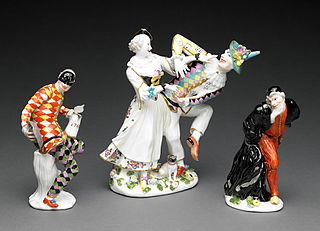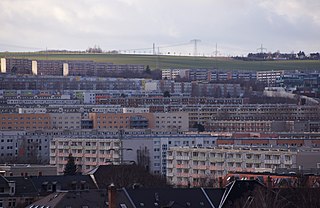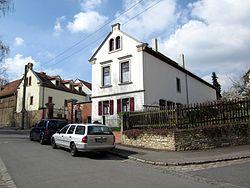
Saxony, officially the Free State of Saxony, is a landlocked state of Germany, bordering the states of Brandenburg, Saxony-Anhalt, Thuringia, Bavaria, as well as the countries of Poland and the Czech Republic. Its capital is Dresden, and its largest city is Leipzig. Saxony is the tenth largest of Germany's sixteen states, with an area of 18,413 square kilometres (7,109 sq mi), and the sixth most populous, with more than 4 million inhabitants.

Meissen is a town of approximately 30,000 about 25 km (16 mi) northwest of Dresden on both banks of the Elbe river in the Free State of Saxony, in eastern Germany. Meissen is the home of Meissen porcelain, the Albrechtsburg castle, the Gothic Meissen Cathedral and the Meissen Frauenkirche. The Große Kreisstadt is the capital of the Meissen district.
Meissen is a district (Kreis) in the Free State of Saxony, Germany. It is bounded by the state of Brandenburg, the district of Bautzen, the urban district Dresden, the districts Sächsische Schweiz-Osterzgebirge, Mittelsachsen and Nordsachsen.

Radebeul is a town in the Elbe valley in the district of Meißen in Saxony, Germany, a suburb of Dresden. It is well known for its viticulture, a museum dedicated to writer Karl May, and a narrow gauge railway connecting Radebeul with the castle of Moritzburg and the town of Radeburg. The Meißen area, where Radebeul is located, is one of the northeasternmost areas where wine is grown in the 21st century.

Moritzburg is a municipality in the district of Meissen in Saxony, Germany, between Meissen itself, an early centre of Saxony, and today's capital Dresden. It is most famous for its Baroque castle, Schloss Moritzburg.

The Bishop of Dresden-Meissen is the ordinary of the Roman Catholic Diocese of Dresden-Meissen in the Archdiocese of Berlin.

Naumburg is a town in the district Burgenlandkreis, in the state of Saxony-Anhalt, Central Germany. It has a population of around 33,000. The Naumburg Cathedral became a UNESCO World Heritage Site in 2018. This UNESCO designation recognizes the processes that shaped the European continent during the High Middle Ages between 1000 and 1300: Christianization, the so-called “Landesausbau” and the dynamics of cultural exchange and transfer characteristic for this very period.

Meissen porcelain or Meissen china was the first European hard-paste porcelain. Early experiments were done in 1708 by Ehrenfried Walther von Tschirnhaus. After his death that October, Johann Friedrich Böttger continued von Tschirnhaus's work and brought this type of porcelain to the market, financed by Augustus the Strong, King of Poland and Elector of Saxony. The production of porcelain in the royal factory at Meissen, near Dresden, started in 1710 and attracted artists and artisans to establish, arguably, the most famous porcelain manufacturer known throughout the world. Its signature logo, the crossed swords, was introduced in 1720 to protect its production; the mark of the swords is reportedly one of the oldest trademarks in existence. Dresden porcelain was once the usual term for these wares, until the Higher Munich State Court decided in favour of the Saxon Porcelain Manufactory Dresden which alone was then allowed to use the name Dresden Porcelain.

Wurzen is a town in the Leipzig district, in the Free State of Saxony, Germany. It is situated on the river Mulde, here crossed by two bridges, 25 km east of Leipzig, by rail N.E. of Leipzig on the main line via Riesa to Dresden. It has a cathedral dating from the twelfth century, a castle, at one time a residence of the bishops of Meissen and later utilized as law courts, several schools, an agricultural college and as a police station including a prison.

Dresden Cathedral, or the Cathedral of the Holy Trinity, Dresden, previously the Catholic Church of the Royal Court of Saxony, called in German Katholische Hofkirche and since 1980 also known as Kathedrale Sanctissimae Trinitatis, is the Catholic Cathedral of Dresden.

Balthasar Permoser was among the leading sculptors of his generation, whose evolving working styles spanned the late Baroque and early Rococo.

Königsbrück is a town in the Bautzen district, in the Free State of Saxony, Germany. It is situated 14 km (8.7 mi) west of Kamenz, and 27 km (17 mi) northeast of the Saxon capital Dresden. Königsbrück is known as the western gate of the historic Upper Lusatia region.

The Diocese of Dresden–Meissen is a Diocese of Catholic Church in Germany with its seat in Dresden. It is suffragan to the Archdiocese of Berlin.

Priestewitz is a municipality in the district of Meißen, in Saxony, Germany.

St. Peter's Cathedral is an interdenominational church in Bautzen, Germany. It is among the oldest and largest simultaneum churches in Germany. Located in the heart of the city's "Old Town", the church and the square it is situated within is a major tourist attraction.

Sidonie of Poděbrady was a duchess consort of Saxony. She was a daughter of George of Poděbrady, King of Bohemia, and his first wife Kunigunde of Sternberg. She was the twin sister of Catherine of Poděbrady, wife of Matthias Corvinus of Hungary.

William I, the one-eyed, was Margrave of Meissen. His surname is related to the legend that Saint Benno appeared to him because of his disputes with the Church in a dream and he had an eye gouged out.

Gorbitz is an area in south-west Dresden, Germany. It is part of the Ortsamtsbereich Cotta, and is subdivided into three Stadtteile: Gorbitz-Nord/Neu-Omsewitz, Gorbitz-Ost and Gorbitz-Sud.

Löbtau is a quarter or Stadtteil in south-west Dresden, Germany. It is part of the Stadtbezirk Cotta. It borders the quarters of Friedrichstadt, Cotta, Gorbitz, Naußlitz, Dolzschen, Plauen and Südvorstadt.
Albrecht I of Meissen was Bishop of Meissen from 1150 to 1152.





















